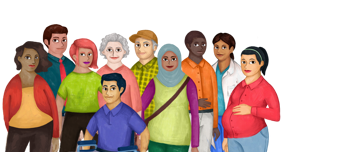
Credit: Getty Images
On April 10, the All of Us Research Program released SAS Viya (known as “SAS Studio”) on its cloud-based Researcher Workbench platform. In the point-and-click SAS Studio application, researchers can perform powerful statistical analyses and data visualizations with data from electronic health records, surveys, wearables, and more. This release could open opportunities for additional researchers to join the more than 10,100 researchers already on the platform and power new health insights.
“We now have even more tools on the Workbench, making the platform more accessible for researchers,” said Romuladus Azuine, Dr.PH., M.P.H., Chief of the Researcher Platforms Branch at All of Us. “We are hopeful that this will bring more researchers interested in precision medicine research to explore the data contributed by our participants.”
Bringing SAS to the Workbench
All of Us worked with the SAS Institute to bring SAS Studio to the Workbench. As part of that process, three teams of researchers were invited to test SAS Studio within the Workbench prior to its launch using demonstration projects. Joyonna Gamble-George, Ph.D., MHA, Associate Research Scientist at the Yale University School of Public Health, was one of those researchers.
Dr. Gamble-George became involved with All of Us a few years ago as part of the All of Us Biomedical Researcher Scholars Program at the Baylor College of Medicine where she worked as part of an interdisciplinary team that conducted a research project within the Workbench.
That experience not only gave her the opportunity to become part of the SAS pilot program, but also helped shape her views on how bringing SAS Studio to the Workbench could further team science. “I’m a neuroscientist by training. As a basic biomedical scientist, I realized that my research could only go so far in understanding how social and behavioral factors influence health. We must have interdisciplinary research to understand how social factors impact health outcomes,” said Dr. Gamble-George. “Bringing SAS Studio to the Workbench opens the door to collaborations across disciplines between the biological sciences and the social and behavioral sciences.”
For their SAS Studio demonstration project, Dr. Gamble-George and Fatemeh Choupani, Ph.D., RN, Assistant Professor at Seattle University, explored how social determinants of health (SDOH) influence behaviors and health outcomes after people experience a life-threatening medical event.
SDOH are “nonmedical factors that influence health outcomes,” such as living in poverty, lack of access to health care, lack of education, and experiences of stigma and racism.
Dr. Gamble-George and Dr. Choupani first used electronic health record data to identify All of Us participants who had experienced life-threatening events, such as a heart attack, stroke, and severe allergic reaction. Then, they used the All of Us Basics, Health Care Access and Utilization, Lifestyle, Personal and Family Health History, and SDOH surveys to look at participants who also had data available about SDOH. Researchers can visit the analytics guide based on this project to learn how to estimate the prevalence of SDOH among adults who have experienced a life-threatening event.
“We are grateful to our SAS Studio demonstration project researchers for testing the tool on our platform,” said All of Us Chief Engagement Officer Karriem Watson, D.H.Sc., M.S., M.P.H. “I hope that releasing more tools will address the needs of multiple researcher communities and foster innovative use of our data by more people.”
Working with SAS
SAS must be licensed for use, so many researchers are used to paying for this license. At this time, registered researchers do not need to pay for a SAS license while using the SAS Studio application in the Workbench.
Researchers who have a personal or institutional SAS license cannot use that software to analyze All of Us data because the data can only be accessed within the Workbench and cannot be downloaded.
For researchers looking to get started with SAS Studio, All of Us has provided a suite of support materials. Importantly, the SAS Studio demonstration projects are available as featured workspaces within the Workbench and as analytics guides on the User Support Hub. Registered researchers can copy the featured workspaces in the Workbench and consult the analytics guides for additional help.
“The analytics guides outline step-by-step how demonstration project researchers, like Dr. Gamble-George and Dr. Choupani, put together their analyses and how they carried them out using SAS Studio,” said Izabelle Humes, PT, D.P.T., M.S., Scientific Research Project Manager at the All of Us Data and Research Center. “This makes it easy for researchers to jump-start their analyses in SAS Studio.”
Getting Access to the Workbench
Researchers may register for the Workbench to gain access to All of Us data and the robust set of analytical tools, including SAS Studio, RStudio, and Jupyter Notebooks. To start the registration process, researchers should first check if their institution has a Data Use and Registration Agreement (DURA) with All of Us. Researchers whose institutions have a DURA in place may begin the registration process. Those whose institutions are eligible and do not yet have a DURA can start the process to get one on ResearchAllofUs.org.
Explore SAS Studio resources on the User Support Hub.
This article appears in the April 2024 issue of All of Us Research Roundup. Subscribe to receive future issues of the bimonthly researcher newsletter.
View the full April edition of the All of Us Research Roundup here.
All of Us is a registered service mark of the U.S. Department of Health & Human Services (HHS).
 U.S. Department of Health & Human Services
U.S. Department of Health & Human Services

